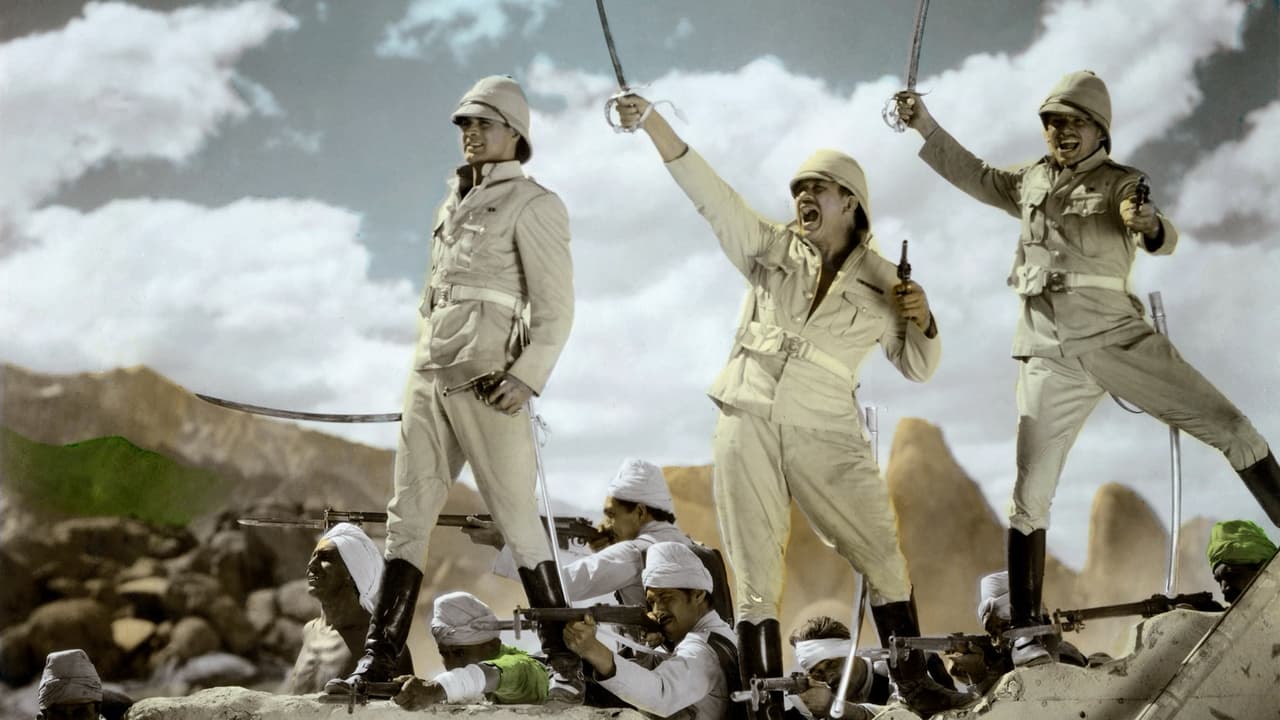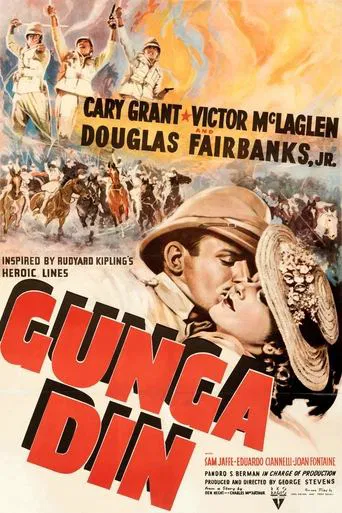

Plot so thin, it passes unnoticed.
... View Morejust watch it!
... View MoreThis is a small, humorous movie in some ways, but it has a huge heart. What a nice experience.
... View MoreThere is, somehow, an interesting story here, as well as some good acting. There are also some good scenes
... View MoreIn 19th century India, three British soldiers and a native water bearer (Sam Jaffe) must stop a secret mass revival of the murderous Thuggee cult before it can rampage across the land.Time gave "Gunga Din" a positive review. However, they also noted that the film was part of a recent Hollywood trend of manufactured screwball comedies, re-releases, remakes, and thinly disguised remakes; comparing "Gunga Din" to several previous films such as "Lives of a Bengal Lancer", "Charge of the Light Brigade", and "Drums". Although they were not wrong, it is interesting to note that today (2015) it is really only "Gunga Din" that is remembered, with maybe "Bengal Lancer" a distant second.In the 1984 film "Indiana Jones and the Temple of Doom" the events in "Gunga Din" are alluded to by the character Captain Blumburtt. Also many of the events and scenes in the film are taken directly from "Gunga Din", including giving the Thuggee leader a shaven head and similar look. Others have suggested the film was an influence on "Star Wars", and that can certainly be seen to a point.
... View MoreWhat all the critics of this movie today fail to understand the Wright brothers didn't make a Stealth Fighter or a Boeing 747. Steve Jobs' first computer wasn't an iPhone 6 Plus. Bill Gates didn't start out by making Windows 8 (thank God!). Teenagers today look at the original King Kong and call it stupid and amateurish. But when it came out, audiences were in awe. When Al Jolson first sang in the Jazz Singer, people couldn't believe that there could ever be such a thing as a talking picture. And, when Captain James T. Kirk, in 1966, first used his communicator, no one ever thought that such a thing was possible—a box that you hold in your hands that works like a telephone without wires. Today, "communicators" even come with built-in cameras, a built in televisions, miniature computers and pinball machines, not to mention the entire wall of maps from AAA, along with a little person inside to talk to if you get lonely.Gunga Din (pronounced Gunga Deen) is a story of camaraderie, not war. Cary Grant and Douglas Fairbanks, Jr. were huge box office draws back then (yes, boys and girls, even bigger than Leonardo DiCaprio) and people went to their movies to see them. Back then, people didn't go to the cinema to be educated, to watch Lincoln or Silkwood. They didn't want the reality of Transformers. They wanted to get away from reality. They got all the reality they needed from the newsreels that came after the cartoons. They were about to enter World War II. More than half of the men would be shipped overseas to fight Hitler and many would never return.Gunga Din was a fun picture. It didn't matter if was sent in India or Brazil. As with the Treasure of the Sierra Madre, it was about the lives of the main stars and how they interacted with each other. Watching it, I could only feel saddened by the thought that everyone involved in that film is now dead. Joan Fontaine was the last survivor. Cary Grant was simply stand out. He always was. I mourn the loss of all of them, even the bad guys. And I thank them for the legacy they left, which became a stepping stone for future film makers and actors to build upon.
... View MoreGunga Din is produced and directed by George Stevens and co-adapted to screenplay by Ben Hecht, Charles MacArthur, Joel Sayre and Fred Guiol. It's loosely inspired by the Rudyard Kipling poem of the same name. It stars Cary Grant, Victor McLaglen, Douglas Fairbanks Junior, Eduardo Ciannelli, Sam Jaffe and Joan Fontaine. Music is by Alfred Newman and cinematography by Joseph H. August.1939 was a golden year for cinema, a raft of classic movies were produced, many of which still hold up today. Unfairly suffering under scrutiny for its colonialist attitudes and embracement of war is Gunga Din, RKO Pictures' magnificent action adventure. Political Correctness in this day and age has led some to be sniffy towards Stevens' movie, it seems that to understand the period from when the film was made is a stretch too far. Balderdash say I. Really in this instance no charges should stand or be considered for this is a movie that should be heralded and treasured for the template it is. This was after all an anti-dote to the Great Depression that was drawing to a close, and with WWII kicking off, the likes of Gunga Din were medicine for the wounded millions.For the love of Kali: Kill, Kill, Kill.Undeniably it's preposterous and over the top, that's kind of the point really. It's a live action cartoon for the adults to enjoy whilst the kiddies get swept up in the gusto of it all. You don't have to condone anything by feeling uplifted as Gunga Din plays on themes such as loyalty, bravado and friendship, to go in deep with a good ole battle of good against evil, where fists fly and gunshots fill the air. Where hundreds of horses hooves pace in time with your heart. It's a spiffying adventure yarn deftly constructed by Stevens and his team. There's much light hearted interplay between our three stoic heroes, and the fist fight scenes have a charming silent movie feel to them, further enhancing the joviality that pulses throughout. And yes, there is sentiment, even a bit of cornball thrown in for good measure, but it lands in the cinema lover's heart and helps it beat happily.You Lazarushian-leather Gunga Din!Cast are having a great time, especially Grant who revels in playing knuckles and delivering songs about British Roast Beef! Newman's score is a neat blend of heroic bluster and exotic reflections, and the California locations, notably Alabama Pine, are expertly used by Stevens and August, the latter of which was nominated for an Academy Award for his efforts. Production design is eye catching, with the Indian temples standing out, while the final battle showcases Stevens' strengths in composition and action construction. Its influence should not be understated either, you can trace a line from this to Indiana Jones, and even beyond to the big box office coffer fillers like National Treasure and The Mummy et al. Gunga Din, an ode to good time cinema from a golden age, bravo! 9/10
... View MoreDerived from the Rudyard Kipling poem, this adventurous relic stars Cary Grant, Victor McLaglen and Douglas Fairbanks Jr. as Cutter, MacChesney and Ballantine, in that order. Sam Jaffe's Gunga tags along. Ballantine is about to retire from the military to be with his wife Emmy while his mates want him to take another tour. The film begins not with this trio but with the surprise attack of a British convoy who face an inconspicuous group of Indian trekkers who slay them in their sleep. When the company never returns, the military starts to fret, validated when communicating with one of their headquarters and communication is abruptly severed.Disentangled from a huge bar brawl over a phony treasure map, the three soldiers are penalized by leading a party to the small village where the British telegraph operator and army base was. There, their group is gradually dispatched by the hostile natives who led the initial attack only to be shown what for by the practiced scuffling of the trio. They unearth the existence of a treacherous insurgence that wants nothing short of the complete obliteration of the British army. Their plans are further developed when Cutter goes off with Din seeking a temple of gold where they expect to find the incentive to persuade Ballantine to rejoin. Eduardo Ciannelli is excessively tanned and forcefully overzealous as the Guru in command of the mutiny. He speaks practically superior English to his peers. Fontaine is hardly in the picture, so measuring her squandered performance against the male players feels pointless.Making use of the impact of popular movies of the era, the music score is mindlessly audacious, just like the British trio at the hub of the picture. And keeping consistent with the three main characters, when the music needs to be more striking or restrained, it becomes even more customary and pompous. Alfred Newman's best score has one or two moments that work adequately, though like most Golden Age films, there are a few sequences of silence that are more effective than over half of the scored ones. The film seems very much like a pathwork of conventional patterns that never convey themselves inventively. George Stevens was clearly attempting to create something with the heart of a high seas adventure and less a war drama. He strives to generate a degree of thrill that's only effective in a few scenes, such as the climactic moments and wrap-up of the movie, but not in others, like the rooftop fight.One nevertheless acclimatizes to the movie's qualitative footing in its own time, and we can give in in view of that. Grant is delightful and lively without the urge to bogart the spotlight, which he splits with his co-stars. McLaglen is a presence and Fairbanks Jr. hangs generally in the wings. The three work extremely well together, which provides a degree of brotherhood vital to their character arcs. Much like other films of the 1930s, Jaffe's performance is ornamented with twitches and pigeonholes that carry the character without supplying much dimension, but he introduces enthusiasm into the part that allows us to grow an feeling connection to his wishes to become a real warrior.
... View More